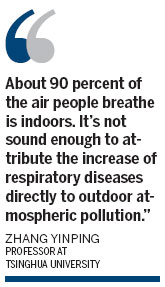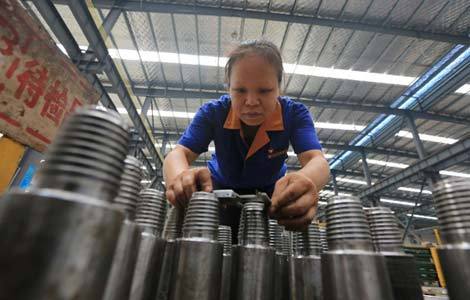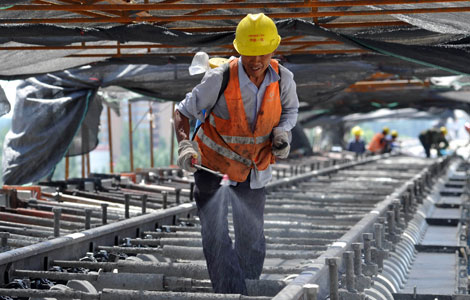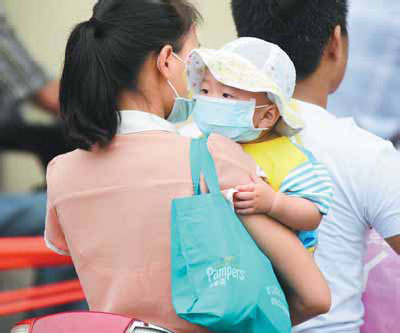Lifestyle changes may hike child asthma cases
Updated: 2013-07-16 07:14
By Wang Qingyun (China Daily)
|
||||||||
|
A woman and her child protect themselves from pollution in Zhengzhou, Henan province, in June. Deng Yinming / for China Daily |

To keep her 7-year-old daughter's asthma under control, Zhang Yun has already gotten rid of her stuffed toys, and her room is fitted with an air purifier which cost about 3,000 yuan ($488.7).
Yet the mother realizes she is powerless when it comes to the air outside.
"She sneezes and coughs when the air quality is not good," she said. "Sometimes my daughter sneezes so hard her nose bleeds."
Zhang is among the many parents in Beijing and other Chinese cities who worry that the increasing air pollution may worsen their children's condition.
In the past two decades, the prevalence of child asthma has risen significantly. But experts are cautious over what role pollution has played.
A survey found that national prevalence surged from 1.09 percent in 1990 to 3.01 percent in 2010, with 23 cities indicating an increase in all three surveys, in 1990, 2000 and 2010.
The prevalence of asthma among children under 14 in Beijing is 3.68 percent, up from 0.88 percent in 1990 and 2.69 percent in 2000, while in Shanghai it has risen from 1.79 percent in 1990 to 7.57 percent in 2010, higher than any other city surveyed that year.
Liu Chuanhe at the Capital Institute of Pediatrics in Beijing, who helped conduct the survey, said changing lifestyles has been a definite cause for the increase.
"In Beijing, we found most children diagnosed with asthma were allergic to mites and mold, some to pollen or animal fur," he said.
"We enjoy air-conditioning in summer and heating in winter, so people barely open their windows and doors to ventilate their apartment. This makes it easy for mites and mold to grow, like on pillows, sheets and in the air conditioners."
Also, consumption of high-protein foods increases the risk of allergies in children, including asthma, Liu said.
He dismissed suggestions that air pollution alone is responsible for the increase.
"The link increasing asthma to worsening outdoor air pollution has not been confirmed," Liu said. Pollution, such as particulate matter and sulfur dioxide, has not been proven to trigger new asthma cases in children, he said.
"However, the air pollution can worsen the recovery for children with asthma," he said. "During smoggy weather, more parents take their children to me than usual.
"They may not have an attack of asthma for breathing smog, but they usually experience symptoms such as a runny nose and chest tightness."
Long-term exposure to air pollution is extremely adverse to controlling child asthma, and frequent attacks increase the risks of someone suffering the disease after growing up, and even developing chronic obstructive pulmonary diseases, he warned.
Zhang Yinping, a professor at Tsinghua University's School of Architecture, said he believes that household decorations are also to blame for the increase in child asthma.
In January he released findings in the Chinese Science Bulletin in which he surveyed more than 48,000 children in 10 cities.
The findings showed that Shanghai had a higher prevalence of asthma among children than any of the other nine cities - 9.8 in every 100 kids aged 3 to 6 in Shanghai were diagnosed with asthma in 2011.
However, it had the lowest concentration of PM10, particles whose diameter is at most 10 micrometers and can be inhaled, in 2010.
"Decorations, including semi-volatile organic compounds such as plastics and flame retardant in furniture, may have a greater influence on causing asthma than outdoor air pollution of PM10," he said.
"We speculate the decorations in apartments are probably the reason why Shanghai has the highest doctor-diagnosed asthma prevalence.
"About 90 percent of the air people breathe is indoors. It's not sound enough to attribute the increase of respiratory diseases directly to outdoor atmospheric pollution."
But the results do not mean air pollution is irrelevant to the cause of the disease, given that PM10 is only part of the pollutants, he admitted.
Wu Yonghong is taking no chances, however. Her 12-year-old daughter relieves her asthma by swimming regularly, and Wu said she does not let her daughter do outdoor exercises when the air is bad.
"I have a treadmill and an air purifier for her in our house, so she can do some exercise during smoggy days," she said. "The air pollution, surely, is bad for her recovery.
"All I can do is try my best to lower the exposure by having her wear masks, and shutting doors and windows and turning on the purifier."
wangqingyun@chinadaily.com.cn
(China Daily USA 07/16/2013 page6)

 Obama urges restraint amid protests
Obama urges restraint amid protests
 Putin wants Snowden to go, but asylum not ruled out
Putin wants Snowden to go, but asylum not ruled out
 Apple to probe death of Chinese using charging iPhone
Apple to probe death of Chinese using charging iPhone
 Investment falters as industrial activity flags
Investment falters as industrial activity flags
 Rape victim's mother wins appeal
Rape victim's mother wins appeal
 Reproduction of 'Sunflowers' displayed in HK
Reproduction of 'Sunflowers' displayed in HK
 Land Rover enthusiasts tour the world
Land Rover enthusiasts tour the world
 US star sprinter fails drug test
US star sprinter fails drug test
Most Viewed
Editor's Picks

|

|

|

|

|

|
Today's Top News
China calls for new talks on Iran nuclear issue
Global warming may largely raises sea level
Putin wants Snowden to go, asylum not ruled out
Top foreign study destinations for Chinese
Trailblazer reaches out to inmates on death row
Air crash payouts could differ
Cabinet promises more funds for smaller firms
Capital prison tests therapy on inmates
US Weekly

|

|







